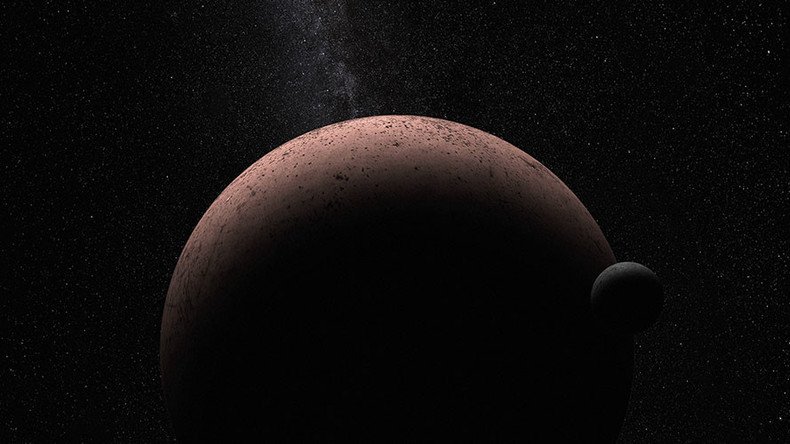Hubble Telescope’s ‘eagle eye’ camera finds new moon orbiting Pluto-like dwarf planet

The Hubble Space Telescope’s “eagle eye” has spotted a tiny, previously unseen dark moon orbiting Makemake, a dwarf planet friend of Pluto’s. Makemake’s bright light had obscured the moon, which now may reveal more about the recently-discovered planet.
A team of researchers who found Makemake back in 2005 also happened upon its petite moon, nicknamed MK 2. Estimated to be 100 miles across in diameter, MK 2 is circling the dwarf planet at an approximate distance of 13,000 miles.
Makemake, a relatively recent discovery itself, is located in the Kuiper Belt, home to several dwarf planets. Measuring just 870 miles in diameter, it is one of five dwarf planets recognized as such by the International Astronomical Union.
Hubble discovers moon orbiting the dwarf planet #Makemakehttps://t.co/yPsuQRYEkepic.twitter.com/BQnyQasrhL
— HUBBLE (@HUBBLE_space) April 27, 2016
It is also the second brightest icy dwarf planet after Pluto. Its brightness is one of the main reasons why researches could not see its moon until now. MK 2 is more than 1,300 times fainter than Makemake.
Thanks to Hubble’s unique ability to catch faint objects near bright ones, they plucked out MK2 from Makemake’s glare last April.
“Our preliminary estimates show that the moon’s orbit seems to be edge-on, and that means that often when you look at the system you are going to miss the moon because it gets lost in the bright glare of Makemake,” Alex Parker of Southwest Research Institute, Boulder, Colorado said in a statement.
Parker and his team announced their discovery in a Minor Planet Electronic Circular Tuesday. The same Hubble technique that helped them find Pluto’s small satellites in 2005, 2011, and 2012 was used.
MK 2’s detection is hoped to bring more insight not just into Makemake, but the dwarf-planet system in general, its mass and evolution.
“Makemake is in the class of rare Pluto-like objects, so finding a companion is important,” Parker said. “The discovery of this moon has given us an opportunity to study Makemake in far greater detail than we ever would have been able to without the companion.”
The researchers still need to learn more about MK 2’s orbit, whether it is elliptical or circular. If, for example, it is circular, the moon would complete a circuit around Makemake in 12 days or longer, researches assume.
Knowing the shape of the moon’s orbit would also be helpful in order to find answers about Makemake’s origin. A tight circular orbit means that MK 2 most likely appeared after a collision between Makemake and another Kuiper Belt object several billion years ago. If the moon moves in a wide, elongated orbit, it is more likely to have been a captured object from the Kuiper Belt, taken when the solar system was younger.
'Psychedelic Pluto': #NASA releases stunning rainbow-colored image of dwarf planet https://t.co/2MeD5L5sR0pic.twitter.com/qbRiT3pm4K
— RT (@RT_com) November 13, 2015
Another curious fact is MK 2’s charcoal black color. Parker’s team believes it comes from the fact the moon is so small that it lacks the gravitational power necessary to hold onto a bright, icy crust. If true, this would make MK 2 similar to comets and other Kuiper Belt objects, many of which have the same feature.












